Virginia is a beautiful state that has a lot of appealing, culturally diverse sites to offer its people.
The one thing that will stand out the most to bird lovers is the many types of birds you can find there, with their different appearances, sizes, and population rates.
In this article, we’ll shed light on the 8 most common species of woodpeckers in Virginia. We’ll also discuss how to identify each and every one of them.
8 Types of Woodpeckers in Virginia
Now let’s see what makes every bird on this list unique in its own way
1. Red-Cockaded Woodpecker
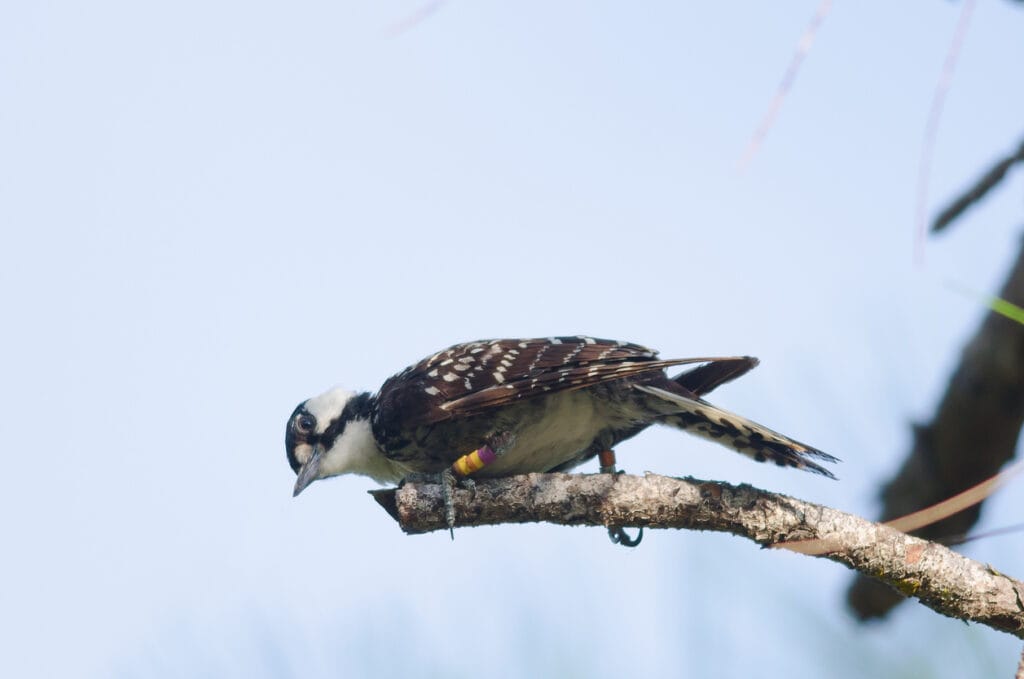
Don’t let the name fool you. Red-cockaded Woodpeckers aren’t actually red. In fact, what makes these woodpeckers distinguishable are their black capes, white cheeks, and the black and white patterns on their backs.
The “Red-cockaded” in their name comes from the small red splash on the side of the male’s black cape, but you can hardly see it anyway. Note that the female doesn’t have that red patch, and juvenile Red-cockaded Woodpeckers have it in the center of their heads.
Author Note: Red-cockaded Woodpeckers are 7.9-9.1 inches long and weigh around 1.5-1.8 oz with a wingspan of 13-16 inches.
Originally, you could’ve found Red-cockaded Woodpeckers in old pine forests with open understory where fires can erupt every now and then. But now, you probably need to visit a protected national forest or wild refuges to see them.
As felling and fire suppression continued, it became more difficult for these woodpeckers to find a suitable environment to live in, and so it was added to the list of endangered species, as their numbers dropped from 1.5 million to 10,000 woodpeckers.
In the past few years, however, a lot of efforts were put into preserving the Red-cockaded Woodpecker’s life.
Red-cockaded Woodpeckers eat insects and arthropods, such as ants, beetles, and wood roaches. They also occasionally eat fruit and seeds.
2. Red-Headed Woodpecker
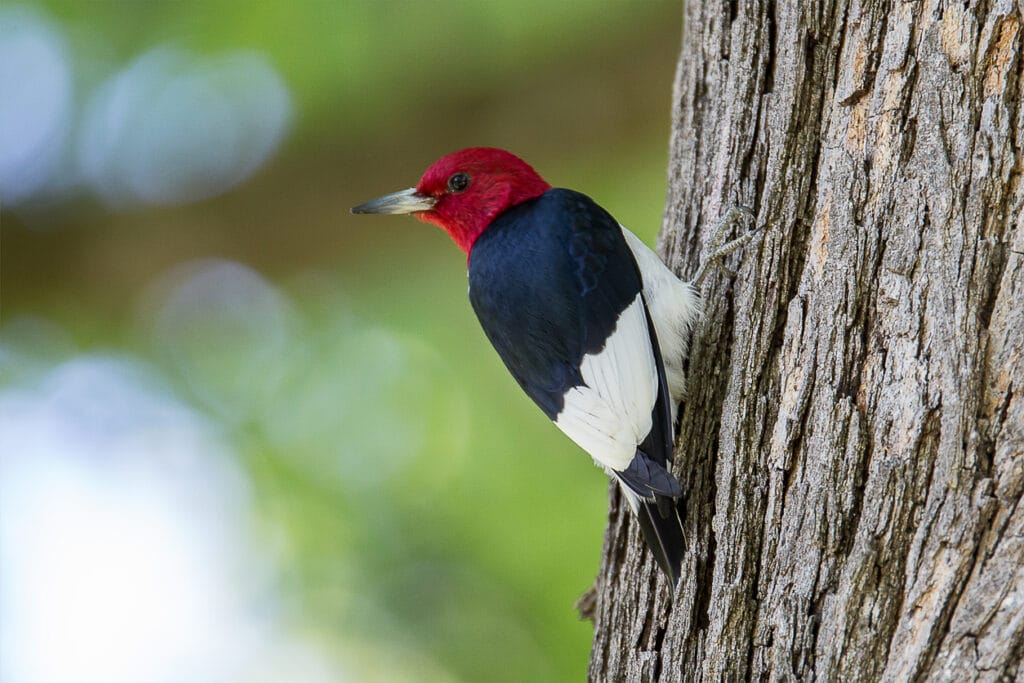
As the name suggests, the Red-headed Woodpecker has a red head, black wings with white stripes, and a white belly. The chicks are usually born with brown heads, but they develop the red color as they mature.
Red-headed Woodpeckers are 7.5-9.8 inches in length and weigh 2-3.2 oz with a wingspan of 16.5-16.7 inches.
Since you can’t tell the difference between the adult male and female Red-headed Woodpecker based on appearances, you need to observe their nesting behavior.
While both the male and the female build the nest together, the male does most of the drilling. Also, both parents take part in the incubation, but you’ll notice that the male does it at night.
You can find Red-headed Woodpeckers in forest edges, open pine woods, or orchards. Whatever forested area they inhabit, it’s important that it’d have dead trees. Dead trees are important for nesting.
Unfortunately, dead trees aren’t aesthetically pleasing to landowners, so they were frequently removed, decreasing the number of suitable nesting sites for the woodpecker.
The decline in dead trees increased the competition between Red-headed Woodpeckers and other species over suitable nesting sites. All of these elements led to a decline in the population of that species.
Red-headed Woodpeckers eat different types of insects, including beetles and grasshoppers. They also eat fruit, seeds, and nuts.
3. Red-Bellied Woodpecker

It’s easy to confuse the Red-bellied Woodpecker with the Red-headed one. You should keep in mind that the Red-bellied Woodpecker doesn’t actually have a red head, just a red cape and nape.
Combine that with the black and white stripes on its back and the faint crimson underbelly, and you’ll get an easily distinguishable bird. Unfortunately, the crimson patch in the underbelly isn’t very visible, so don’t get confused if you don’t see it at first glance.
Note that, while the male has a stark-red cape and nape, the female only has a red nape and a splash of red above its bill.
Red-bellied woodpeckers are 9-10.5 inches long and weigh 2-3.2 oz with a wingspan of 13-16.5 inches.
These woodpeckers are found in different types of woodlands, whether it’s hardwood forests, pine-hardwood forests, or even pine flatwoods.
Unlike Red-headed and Red-cockaded Woodpeckers, Red-bellied Woodpeckers are very flexible. Their adaptable nature has contributed to their expansion and increasing their population in the last few years, as they rate 7/20 on their Continental Concern Score.
Red-bellied woodpeckers eat different types of invertebrates, including flies, ants, and caterpillars. They also eat fruit, nuts, and seeds.
4. Northern Flicker
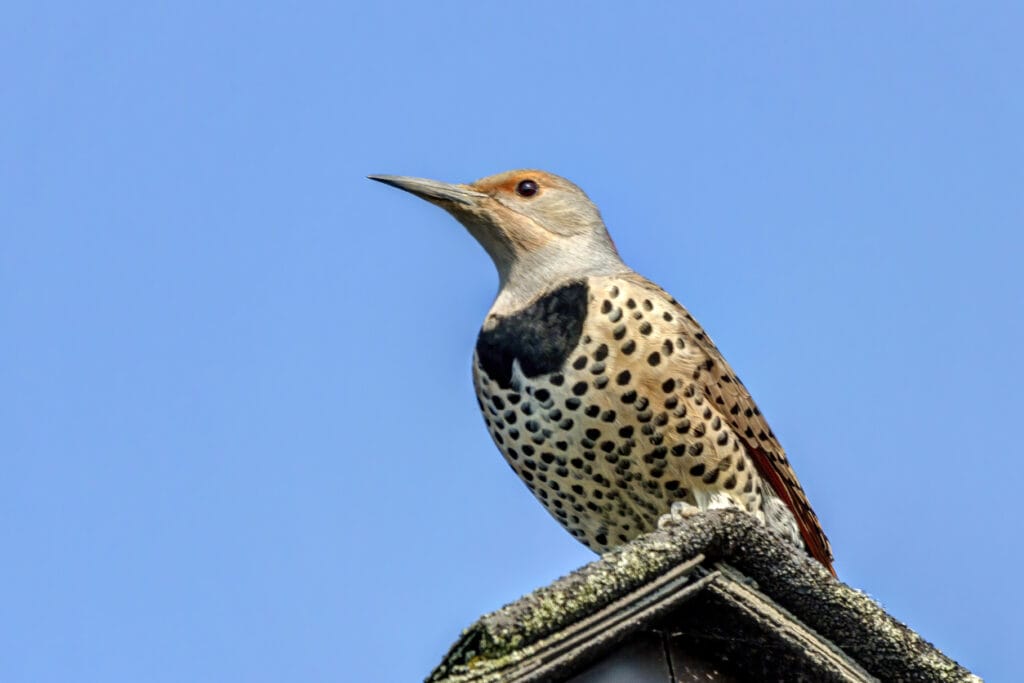
Unlike the black and white plumage that most woodpeckers on this list have, Northern Flickers have an interesting color combination, with brown feathers, black dots on their underparts, and black barring on the back.
But that’s not all. You see, there are actually two forms of Northern Flickers: the Yellow-shafted Flicker and the Red-shafted one. But, only the Yellow-shafted Flicker is common in Virginia, so we’re only going to focus on that form.
Top Tip: The Yellow-shafted Flicker has a brown face and throat, but their upper heads are gray with a red nape.
The male Yellow-shafted Flicker has a black mustache, but the female doesn’t. Both the male and the female have yellow shafts.
Northern Flickers are around 11-14 inches in length and weigh 3.9-5.6 oz with a wingspan of 16.5-20.1 inches. You can find them in any open space with trees, whether it’s parks, groves, or forest edges.
Out of all the woodpeckers on this list, Northern Flickers are the only type that eats from the ground. They eat different types of insects, including ants, beetles, and caterpillars, attacking them from the sky. They also eat fruit, seeds, and nuts.
So, be careful when you’re walking because you might scare some of them off.
Although they’re not in any serious danger, Northern Flickers’ population has been declining, as their homes keep being taken down by humans. They got 10/20 on the Continental Concern Score.
5. Pileated Woodpecker
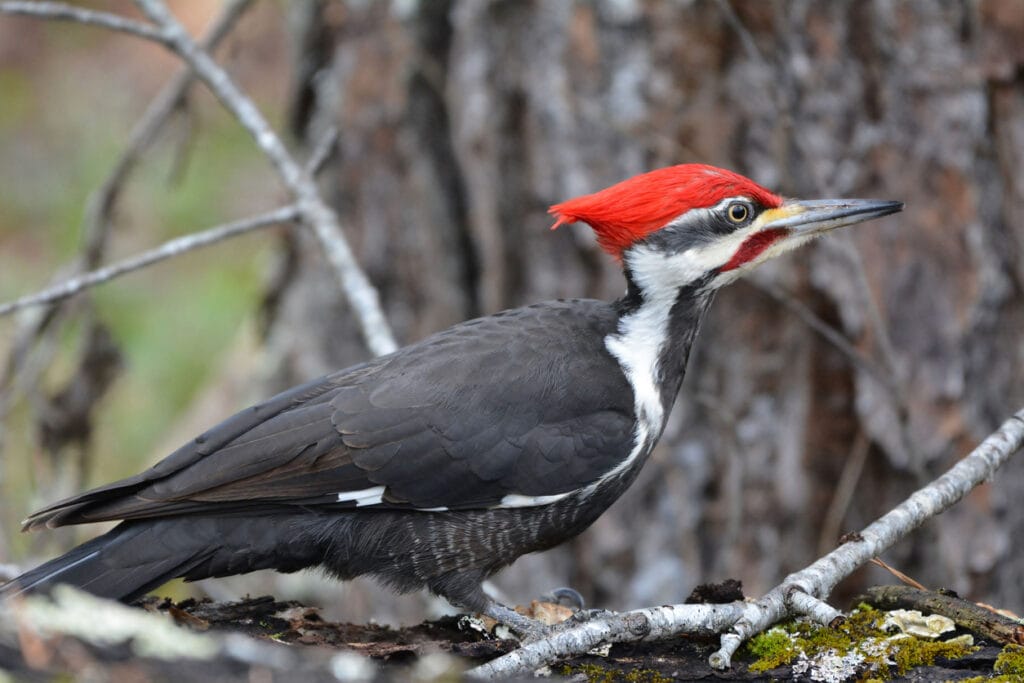
Pileated Woodpeckers have black feathers with a white stripe on the cheeks and throat. Of course, the most distinguishing mark on the bird is its vivid red crest and the red mustache.
You’ll notice that the female Pileated Woodpecker is similar to the male for the most part except that it has a black mustache and forehead, and the red crest is shorter than that of the male.
Pileated Woodpeckers are 15.8-19.3 inches long and weigh 8.8-12.3 oz with a wingspan of 26-29.5 inches. It’s the biggest woodpecker on this list.
Author Note: You can find Pileated Woodpeckers in deciduous forests, whether it’s maple forests or cypress swamps. They can also be found in suburban areas, parks, or any forest that has large, mature, dead trees.
This type of woodpecker isn’t considered an endangered species yet. It even got 7/20 on the Continental Concern Score.
They build their nests and look for food in dead or decaying trees, which humans frequently take down, destroying their food resources and leaving them susceptible to predators.
Pileated Woodpeckers eat different types of insects, mostly carpenter ants, as well as flies, larvae, and caterpillars. They also eat nuts and fruit, such as blackberry and hackberry.
6. Downy Woodpecker
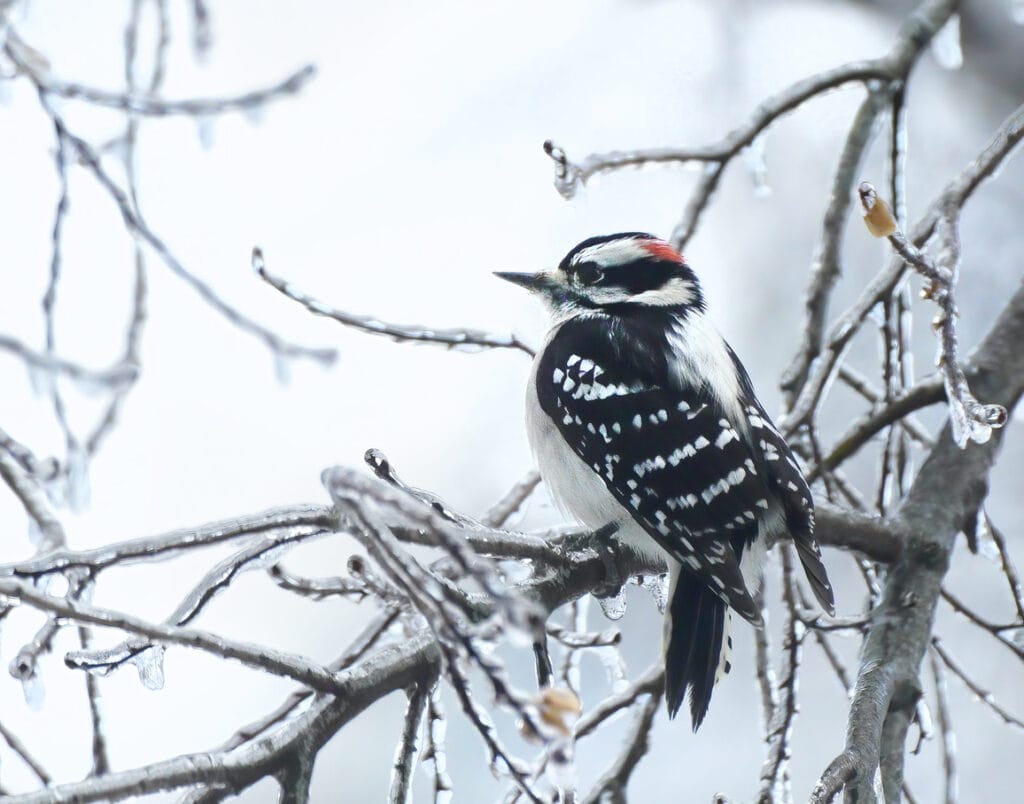
Downy Woodpeckers have the typical black and white plumage of most woodpeckers on this list. They have black wings with white spots, a black head, and a black back with thick white stripes.
You’ll notice that the male Downy Woodpecker has a red patch on his head, while the female doesn’t.
Downy Woodpeckers are 5.5-6.7 in length and weigh 0.7-1 oz with a wingspan of 9.8-11.8 inches. While they’re common in Virginia, actually seeing them might be a bit tricky because of their small size.
Downy Woodpeckers are commonly found in deciduous woods, forest edges, and clearings. You can also find them in parks, orchards, and suburban yards.
They mainly eat insects, such as ants, caterpillars, and beetles. They also eat fruit and seeds, including berries and grain. If you have a suet feeder in your backyard, you might see one or two of them.
Downy Woodpeckers aren’t in real danger, as their numbers have been stable for the most part. With an estimated population of 13-14 million, it was categorized as “Least Concern” in the IUCN Red List.
That categorization means that there isn’t any reason that would make Downy Woodpeckers qualify as endangered.
7. Hairy Woodpecker

Hairy Woodpeckers have black wings with white spots, a black head with white cheeks, and a red splash on the upper side. Combine that with the thick white lines that mark the black back and head, and you’ll notice that the Hairy Woodpecker looks almost exactly like the Downy Woodpecker.
So, how can you tell the difference between them? Size differences should be the first thing you look for. A Downy Woodpecker is 5.5-6.7 inches long, while a Hairy Woodpecker is 7.1-10.2 inches. So, there’s an obvious difference.
In case the difference in size wasn’t obvious enough, you can see how long the bill is. A Downy Woodpecker’s bill is shorter than its head. A Hairy Woodpecker’s bill, on the other head, is almost as long.
If you still can’t tell the difference, you can try to look at the white outer tail of both of them. You’ll notice that Hairy Woodpeckers have plain white outer tail feathers, while the Downy’s outer tail feathers have black barring.
Top Tip: Male Hairy Woodpeckers have a red spot on their upper heads, while females don’t. They weigh 1.4-3.4 oz with a wingspan of 13-16.1 inches.
You can find Hairy Woodpeckers in any deciduous forest with large trees. You can also find them in burned forests, orchards, and suburbs.
Hairy Woodpeckers mostly eat insects. You’ll notice that they target the larvae of bark beetles and wood-boring beetles in particular. But they also eat ants and caterpillars, as well as fruit and nuts.
With a 6/20 on their Continental Concern Score and an estimated population of 9 million, Hairy Woodpeckers seem to be in a stable, healthy condition for the most part.
8. Yellow-Bellied Sapsucker

Yellow-bellied Sapsuckers have white bellies with a hint of yellow. They also have black backs, wings, and tails that are marked by white barring. Though, it’s really the red crests and white stripes around the face that make these birds look special.
You’ll notice that Juvenile Yellow-bellied Sapsuckers look completely different from the adults, with an overall brown plumage instead of black and white.
You can tell the difference between the male and female by looking at their throats. The male has a red throat, while the female has a white throat.
Male Yellow-bellied Sapsuckers are 7.1-8.7 inches and weigh 1.5-1.9 oz with a wingspan of 13.4-15.8 inches.
Unlike many woodpeckers on this list, this type of woodpeckers doesn’t need to live in dead trees specifically.
You can find it in different types of woodlands, whether it’s orchards, forest edges, or pastures. You can also find it in maple and fruit trees since that’s where he gets sap from.
As the name suggests, Yellow-bellied Sapsuckers make holes in the inner part of the tree’s trunk to consume the sap inside it. They also eat spiders and ants, as well as fruit.
The Yellow-bellied Sapsuckers have a stable, healthy population of 10 million. With a 7/20 on the Continental Concern Score, they don’t seem to be any sort of real danger.
Characteristics of Woodpeckers
Here are some of the most common woodpecker characteristics:
Zygodactyl Feet
You’ll notice that woodpeckers usually have feet with two toes facing upwards and two facing downwards. This allows them to easily latch on to trees and feeders in different positions to get their food.
Sharp Beaks and Sticky Tongue
Given that a lot of woodpeckers build their nests and find their food inside trees, it’s only natural to have strong, sharp beaks. The sticky, long tongue helps capture insects inside the trees.
Hyoid Bone
Located in the woodpecker’s cranium, the structure of the hyoid bone protects woodpeckers from the impact of frequent drumming. It also allows the woodpecker to extend its tongue to grab insects.
Wrapping Up
If you’re a bird lover, then Virginia has a lot to offer you. From the Red-cockaded Woodpeckers to the Yellow-bellied Sapsucker and more, you’re going to appreciate the diversity of birds in the Old Dominion.
While the above-listed woodpeckers share a lot of similarities with each other, each bird has its own history, characteristics, and contribution to the world. They’re all unique in their own way!
FAQ
You can find woodpeckers in any wooded area. The Downy and Hairy are pretty common in Virginia and the much larger Pileated Woodpecker is very common. So yes, woodpeckers are common in Virginia.
The Red-cockaded Woodpecker is pretty rare in Virginia with less than a thousand sightings reported on eBird.
Woodpeckers are protected by federal law everywhere including Virginia. It is illegal to remove their nests, harm or hunt them.




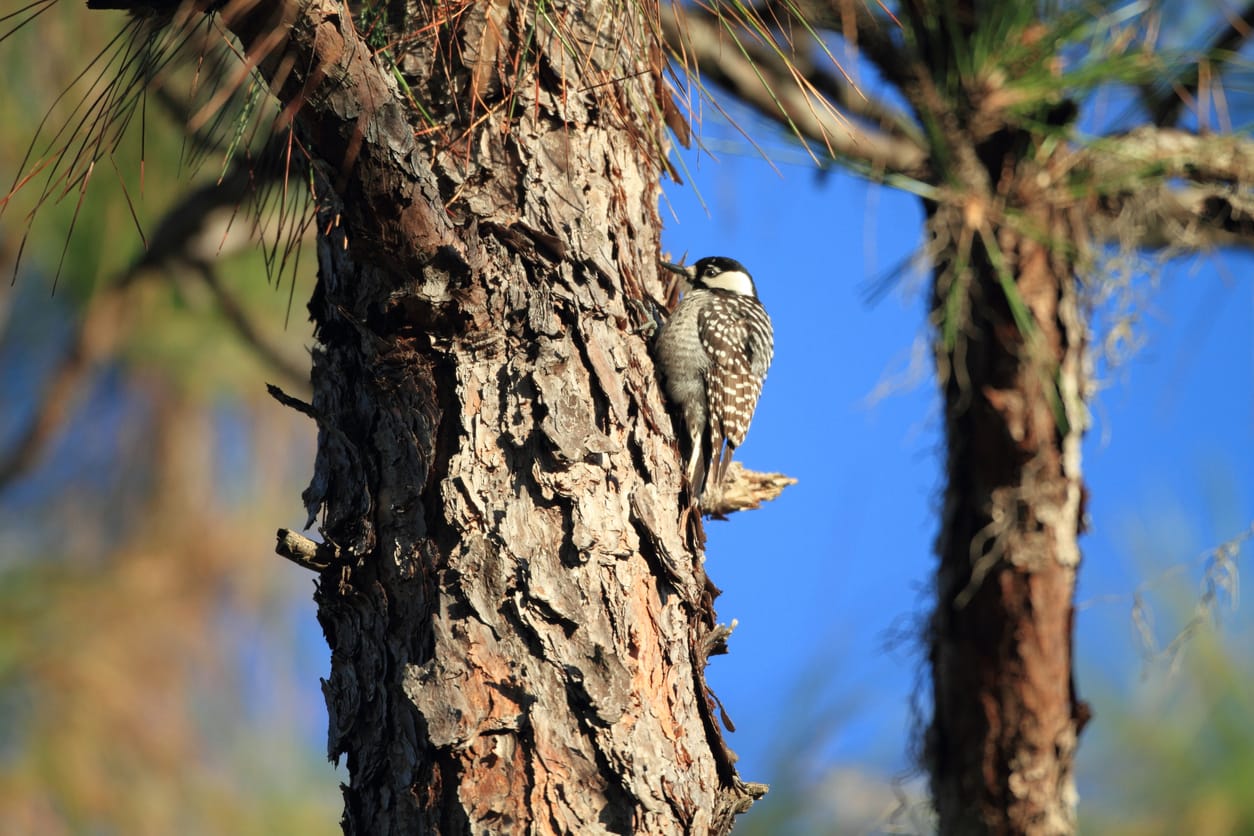

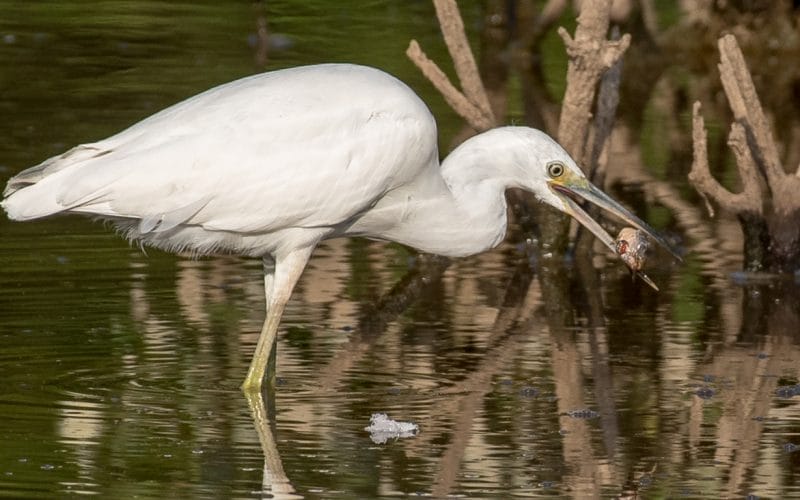
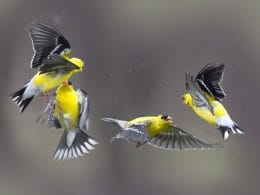

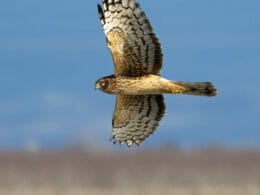

I COULDN’T FIND THE ONE THAT COMES TO MYYYYYYY BIRD FEEDER ALL THE TIME!!!!!!!!